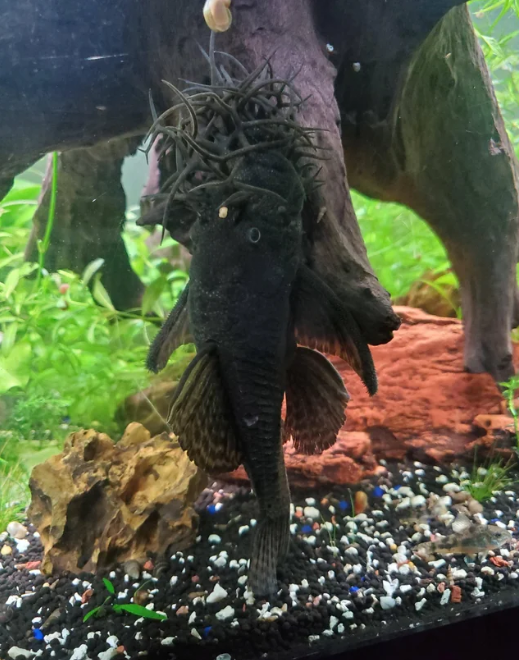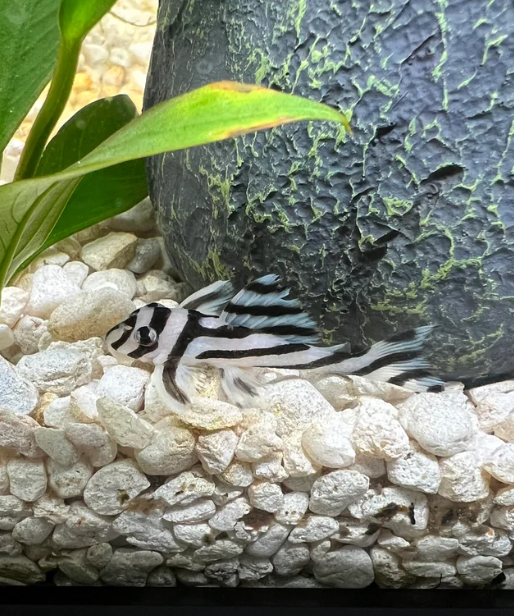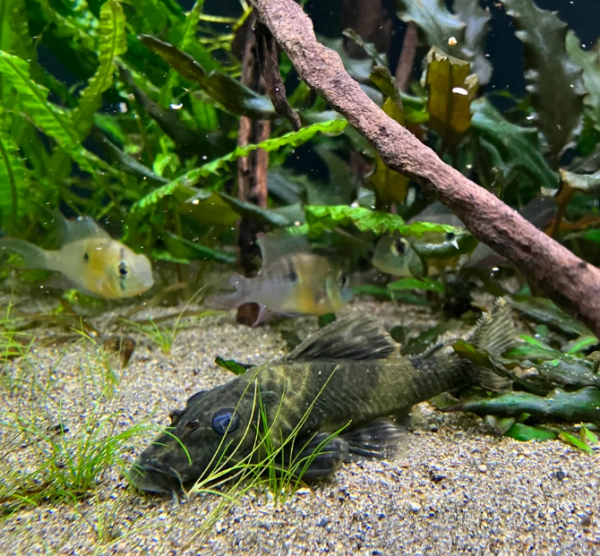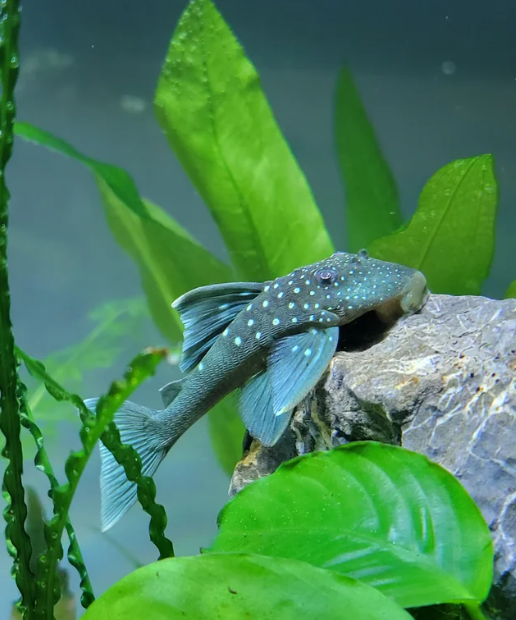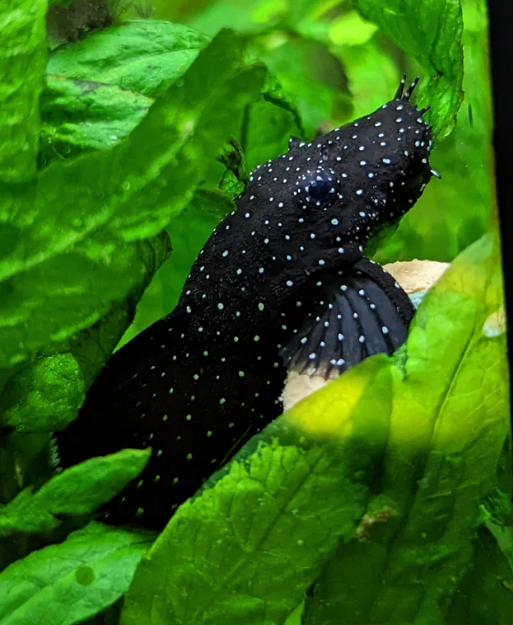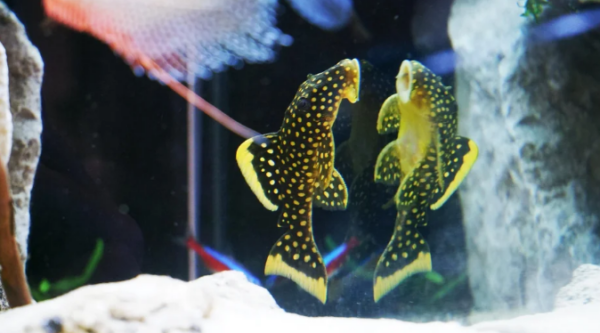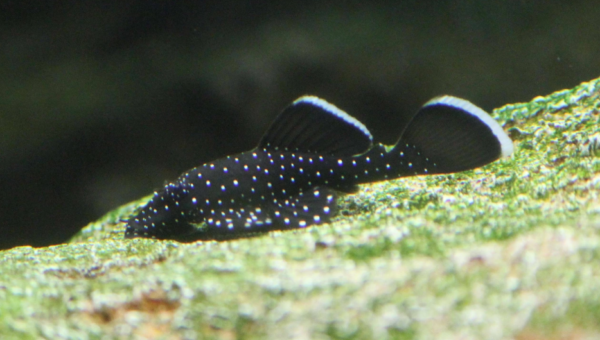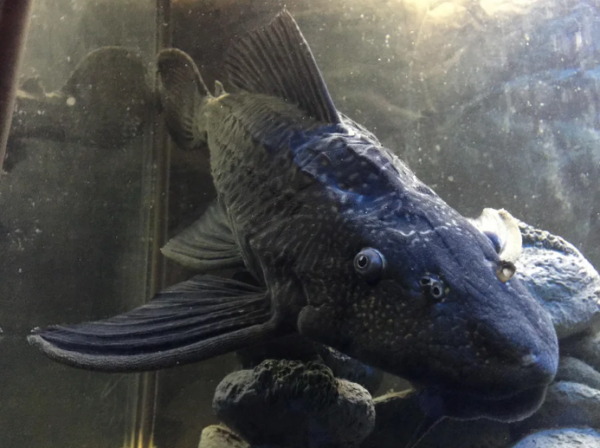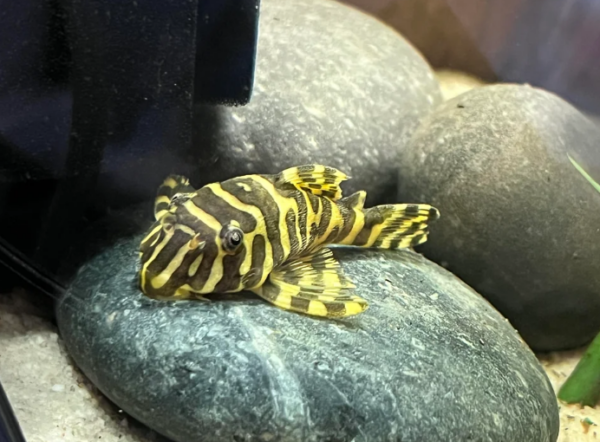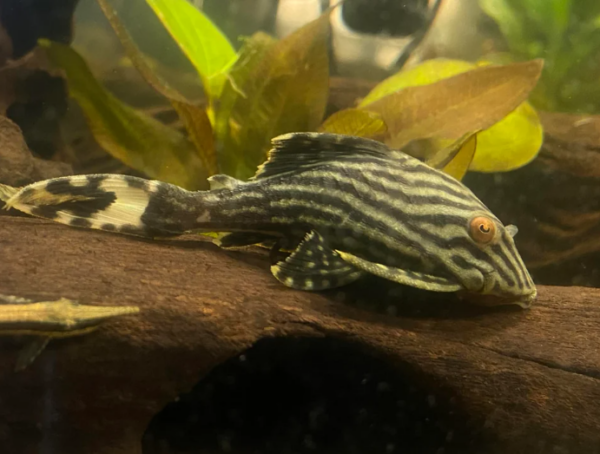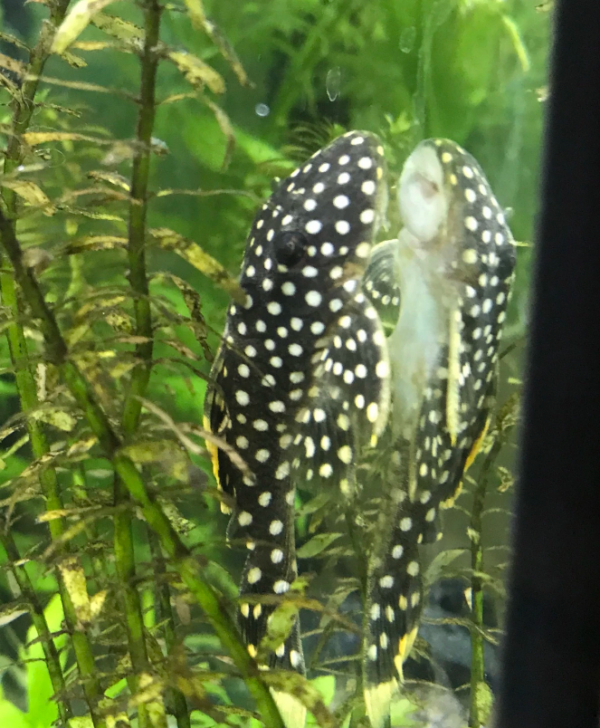Plecos are known for their appearance, adaptability, and peaceful nature. They’re excellent algae-eaters and love to hide behind rocks. In this article, we’ll go through 15 such plecos that are suitable for freshwater aquariums and can become your next best friends.
Table of Contents
15 Types Of Plecos For Your Tank
1. Bristlenose Pleco
| Scientific Name: | Ancistrus cirrhosus |
| Family: | Loricariidae |
| Care Level: | Easy |
| Temperament: | Peaceful. |
| Color: | Dark brown or black with yellow spots |
| Lifespan: | 5 to 12 years |
| Size: | 4 to 6 inches |
| Diet: | Herbivorous. Feeds on Algae, sinking pellets. |
| Minimum Tank Size: | At least 20 gallons. |
| Temperature: | 72 to 82F |
| Water Conditions: | pH 6.5 – 7.5 Soft to moderate hardness |
| Tank Mate Compatibility | Peaceful fish |
Native to South American countries and the Amazon River basin, the Bristlenose Plecos are quite common in the aquarium trade for their unique appearance and algae-eating habits. This species of pleco inhabits slow-moving rivers with rocky substrates.
Bristlenose are dark in appearance with small white or yellow spots covering their whole body. Justifying their name, the Bristlenose Plecos have long tentacle-like appendages or “bristles” on their head and face. Males have more prominent bristles.
The bristles are used for courtship displays.
Their flattened body and sucker-like mouthparts help them cling to surfaces and eat algae from the glass, rocks, and decorations. They’re nocturnal and usually hide during the day.
2. Zebra Pleco
| Scientific Name: | Hypancistrus zebra |
| Family: | Loricariidae |
| Care Level: | Moderate to Advanced |
| Temperament: | Territorial |
| Color: | Distinctive black and white stripes |
| Lifespan: | 10 – 15 years |
| Size: | 3 to 4 inches |
| Diet: | Carnivorous. Bloodworms and brine shrimp. |
| Minimum Tank Size: | At least 20 gallons |
| Temperature: | 74 to 84F |
| Water Conditions: | pH 6.0 – 7.0 Soft to moderate hardness |
| Tank Mate Compatibility | Species-specific compatibility |
Zebra plecos are native to the Xingu River and Amazon River in Brazil. They inhabit rocky areas with fast-flowing water. This species of pleco, surprisingly, is carnivorous and feeds on small crustaceans and invertebrates.
Apart from aesthetic reasons, there is no additional benefit associated with keeping Zebra Plecos. Many aquarists, deceived by their suckermouth, believe they’re algae-eaters, only to release them later in the wild and disrupt the native ecosystem.
Zebra Plecos have a predominantly black body with bright white or cream-colored stripes running horizontally. Their fins also demonstrate such intricate patterns. This small species of plecos don’t go beyond a size of 3 to 4 inches.
Males, during breeding season, exhibit territorial behavior. Otherwise, they’re quite shy and spend the daytime in caves to become active at night.
3. Clown Pleco
| Scientific Name: | Panaqolus maccus |
| Family: | Loricariidae |
| Care Level: | Easy |
| Temperament: | Peaceful |
| Color: | Dark brown or black with light stripes |
| Lifespan: | 10 – 15 years |
| Size: | 3 to 4 inches |
| Diet: | Omnivorous. Feeds on algae and sinking pellets |
| Minimum Tank Size: | 20 gallons |
| Temperature: | 75 to 82F |
| Water Conditions: | pH 6.5 – 7.5 Soft to moderate hardness |
| Tank Mate Compatibility | Peaceful fish |
Inhabiting slow-moving rivers with rocky substrates and driftwood, the Clown Pleco is native to Rio Orinoco and Rio Meta river basins in Venezuela and Colombia. They’re excellent algae-eaters and are kept in aquariums for both their appearance and utility.
Clown Plecos have a darker body and intricate patterns of stripes and spots. These markings resemble clown-like markings. They also lack prominent bristles on their head. However, clowns do have a flattened body and a sucker mouth.
Although omnivorous, Clown Plecos are lenient towards a herbivorous diet. In addition to algae, they prefer sinking pellets, vegetable matter, and bloodworms.
Clown plecos require a lot of hiding spots, such as caves, driftwood, or PVC pipes to feel secure.
4. Rubber Lip Pleco
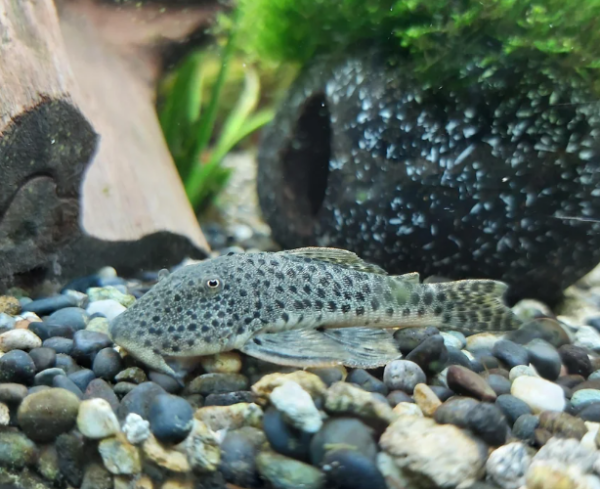
| Scientific Name: | Chaetostoma spp. |
| Family: | Loricariidae |
| Care Level: | Easy to Moderate |
| Temperament: | Peaceful |
| Color: | Brown with rubbery lips |
| Lifespan: | 10 to 15 years |
| Size: | 4 to 6 inches |
| Diet: | Herbivorous. Feeds on Algae, sinking pellets |
| Minimum Tank Size: | At least 20 gallons |
| Temperature: | 72 to 78F |
| Water Conditions: | pH 6.5 – 7.5 Soft to moderate hardness |
| Tank Mate Compatibility | Peaceful fish |
Originated in the Amazon River Basin in Peru, Colombia, and Ecuador, the Rubber Lip Pleco lacks aesthetic looks and is only common in the aquarium trade for its massive algae-eating ability. They inhabit freshwater rivers with rocky substrates.
Small, subtle markings cover their dark brown body. This underwhelming appearance of typical brown or gray coloration is compensated by a rubbery texture on their lips, suitable for scraping algae.
Rubber Lip Pleco are predominantly herbivores and peacefully eat through the algae and biofilm in your aquarium. However, they gladly accept sinking pellets and vegetable matters.
They also are pretty peaceful and can be kept with other non-aggressive fish species in a community tank. Ensure clean water, hiding spots, and appropriate temperature to sustain this practical freshwater aquarium addition.
5. Blue Phantom Pleco
| Scientific Name: | L128 – Hemiancistrus sp. |
| Family: | Loricariidae |
| Care Level: | Moderate |
| Temperament: | Peaceful |
| Color: | Dark body with iridescent spots |
| Lifespan: | 10 to 15 years |
| Size: | 5 to 6 inches |
| Diet: | Omnivorous. Feeds on algae and sinking pellets |
| Minimum Tank Size: | 30 gallons |
| Temperature: | 78 to 82F |
| Water Conditions: | pH 6.5 – 7.5 Soft to moderate hardness |
| Tank Mate Compatibility | Peaceful fish |
Native to the fast-flowing waters of the Rio Orinoco basin in Venezuela, Blue Phantom Plecos are in demand for their striking appearance and peaceful nature. They aren’t efficient algae-eaters and are primarily considered cosmetic additions to the aquarium.
Blue Phantom Plecos have a dark, almost black, body with vibrant electric blue iridescent spots covering their body, including their head and fins. However, they do have a typical pleco shape with a flattened body and a sucker mouth to cling to surfaces.
They also lack prominent bristles on their head and around their mouth.
Typically, this species of pleco relies on an omnivorous diet of algae wafers, protein-rich food, and sinking pellets. But, they also prefer bloodworms, brine shrimp, and small invertebrates.
6. Starlight Pleco
| Scientific Name: | L183 – Ancistrus dolichopterus |
| Family: | Loricariidae |
| Care Level: | Moderate |
| Temperament: | Peaceful |
| Color: | Dark body with light stripes/patterns |
| Lifespan: | 10 to 15 years |
| Size: | 4 to 5 inches |
| Diet: | Omnivorous. Feeds on Algae, bloodworms, and sinking pellets. |
| Minimum Tank Size: | 30 gallons |
| Temperature: | 75 to 82F |
| Water Conditions: | pH 6.5 – 7.5 Soft to moderate hardness |
| Tank Mate Compatibility | Peaceful fish |
Found in the upper Rio Orinoco basin in Venezuela, the Starlight Plecos inhabit slow-moving rivers with rocky substrate and dense vegetation. Impressive in terms of both appearance and abilities, these plecos demonstrate a starry night-like body and algae-eating capacities.
Starlight Plecos, justifying their name, have a dark, black body with small, bright stripes, spots, and lines covering their whole body, especially the fins and the head. Similar to Bristlenose Plecos, this species also has bristles on its head and a flattened body.
This specimen relies on an omnivorous diet of algae, sinking pellets, and protein-rich food. But prefer a herbivorous diet. They’re primarily nocturnal and become more active during the night. Therefore, you need to offer caves and driftwood for them to hide during the day.
7. Gold Nugget Pleco
| Scientific Name: | Baryancistrus spp. |
| Family: | Loricariidae |
| Care Level: | Moderate to Advanced |
| Temperament: | Generally peaceful. Can be territorial. |
| Color: | Golden yellow with dark spots |
| Lifespan: | 10 to 15 years |
| Size: | 6 to 8 inches |
| Diet: | Omnivorous. Algae, sinking pellet, and protein. |
| Minimum Tank Size: | 30 gallons |
| Temperature: | 78 to 84F |
| Water Conditions: | pH 6.0 – 7.5 Soft to moderate hardness |
| Tank Mate Compatibility | Peaceful. Suitable for larger tanks with community fish. |
Native to South American Rio Orinoco and Rio Ventuari river systems, the Gold Nugget Plecos inhabit slow-moving rivers with rocky substrates. Their sticking appearance resembles gold nuggets, hence the common name.
They have a vibrant golden-yellow or orange body covered with dark, intricate spots and markings. Apart from that, they have a typically pleco-like flattened body and a sucker mouth.
Gold Nugget Plecos mostly follow an omnivorous diet and love eating algae and biofilm grown in the aquarium. However, protein-rich food, like brine shrimps and bloodworms, also needs to be included in their diet.
8. Vampire Pleco
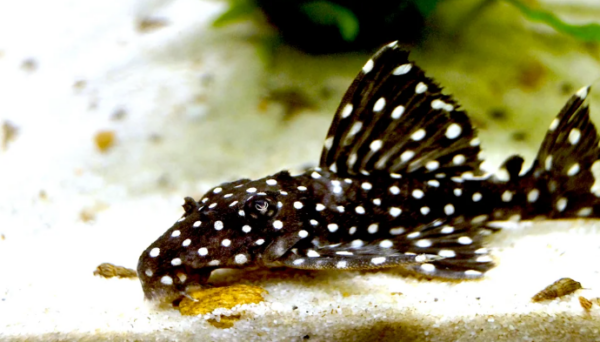
| Scientific Name: | Leporacanthicus spp. |
| Family: | Loricariidae |
| Care Level: | Moderate |
| Temperament: | Semi Aggressive |
| Color: | Dark body with white stripes |
| Lifespan: | 10 to 15 years |
| Size: | 6 to 8 inches |
| Diet: | Omnivorous. Feeds on Algae, proteins, and sinking pellets. |
| Minimum Tank Size: | 30 gallons. |
| Temperature: | 75 to 84F |
| Water Conditions: | pH 6.5 – 7.5 Soft to moderate hardness |
| Tank Mate Compatibility | Other robust fish in larger tanks |
Similar to the appearance of Starlight Plecos, the Vampire Plecos are native to the Rio Orinoco basin in Venezuela. While similar, vampire plecos are larger in size and have sharper teeth than Starlight Plecos.
Vampire plecos have a dark body with a plethora of light, bright white or yellow spots covering their body. Their patterns look more like dots than stars. Otherwise, they have a typical flattened body and a sucker mouth.
They’re efficient algae-eaters and can be kept in community tanks. Their diet involves algae, sinking pellets, and common protein-rich foods.
9. Peppermint Pleco
| Scientific Name: | Parancistrus aurantiacus |
| Family: | Loricariidae |
| Care Level: | Moderate |
| Temperament: | Peaceful |
| Color: | Brown with orange highlight |
| Lifespan: | 10 to 15 years |
| Size: | 4 to 5 inches |
| Diet: | Omnivorous. Consumes algae, proteins, and sinking pellets |
| Minimum Tank Size: | 30 gallons. |
| Temperature: | 78 to 84F |
| Water Conditions: | pH 6.0 – 7.5 Soft to moderate hardness |
| Tank Mate Compatibility | Peaceful fish. Suitable for community tanks. |
Peppermint Plecos are native to the Rio Orinoco River Basin in Colombia with rocky substrates and submerged driftwood. They’re popular in the aquarium trade for their attractive appearance of dark brown bodies with orange or red markings, resembling peppermint candies.
They’re generally peaceful and go along well with other community fish species. Being nocturnal, they’re more active in the night.
Although they’re omnivorous, their diet often leans towards being herbivorous. They’re efficient algae-eaters but require protein-based food for sustainability.
10. Sailfin Pleco
| Scientific Name: | Glyptoperichthys gibbiceps |
| Family: | Loricariidae |
| Care Level: | Easy |
| Temperament: | Peaceful |
| Color: | Black or brown with sail-like dorsal fin |
| Lifespan: | 10 to 15 years |
| Size: | 12 to 20 inches |
| Diet: | Herbivorous. Feeds on Algae, sinking pellets. |
| Minimum Tank Size: | At least 75 gallons. |
| Temperature: | 75 to 82F |
| Water Conditions: | pH 6.5 – 7.5 Soft to moderate hardness |
| Tank Mate Compatibility | Peaceful fish, but best to keep with other non-aggressive fish. |
Predominantly found in the Amazon River basin, Orinoco River Basin, and their river systems, the Sailfin Pleco are excellent algae-eaters. More than their appearance, they’re kept in freshwater aquariums for practicality.
They have a particularly high dorsal fin and unique coloration. Their grayish body color is covered by vertical stripes and spots. The most noticeable feature, their dorsal fin, can be extended and erected when threatened. They also grow pretty big in size and require a larger tank.
Sailfin Plecos typically rely on a herbivorous diet of algae, sinking pellets, and plant matter.
11. Leopard Frog Pleco
| Scientific Name: | L134 – Peckoltia compta |
| Family: | Loricariidae |
| Care Level: | Moderate |
| Temperament: | Peaceful |
| Color: | Tan body with dark-colored spots |
| Lifespan: | 10 to 15 years |
| Size: | 4 to 5 inches |
| Diet: | Omnivorous. Feeds on Algae, protein-based food, and sinking pellets. |
| Minimum Tank Size: | 30 gallons |
| Temperature: | 78 to 84F |
| Water Conditions: | pH 6.5 – 7.5 Soft to moderate hardness |
| Tank Mate Compatibility | Peaceful fish |
Originating in the Rio Orinoco River Basin in Colombia, the Leopard Frog Pleco resembles the markings of a leopard or frog. They inhabit slow-moving streams with rocky substrates and submerged driftwood.
Leopard Frog Plecos have a light brown or tan body with dark, irregular spots covering their whole body. They, otherwise, have a typical pleco-like flattened body and sucker mouth.
They’re effective algae-eaters with a preference for a herbivorous diet. Their diet should consist of algae wafers, sinking pellets, bloodworms, and brine shrimp.
12. Royal Pleco
| Scientific Name: | Panaque nigrolineatus |
| Family: | Loricariidae |
| Care Level: | Moderate |
| Temperament: | Peaceful |
| Color: | Dark brown or black with yellow markings |
| Lifespan: | 10 to 15 years |
| Size: | 12 to 18 inches |
| Diet: | Herbivorous. Feeds on Algae, vegetable matter, and sinking pellets. |
| Minimum Tank Size: | At least 75 gallons or more. |
| Temperature: | 78 to 84F |
| Water Conditions: | pH 6.0 – 7.5 Soft to moderate hardness |
| Tank Mate Compatibility | Peaceful fish. Best to keep with larger non-aggressive fish. |
The large Royal Plecos are native to South American countries of Brazil, Colombia, and Venezuela. They usually inhabit areas with rocky substrates and dense vegetation. This peaceful pleco species is nocturnal and are preferred as algae-eaters in large community tanks.
Appearance wise, Royal Plecos have a dark brown to black body with striking patterns of bright yellow or orange across their body, resembling a royal robe. The rest of their appearance is similar to other plecos with a sucker mouth.
They generally rely on an omnivorous diet with leniency towards algae and plant matter. However, they also need protein-rich food to sustain their massive size.
13. Candy Striped Pleco
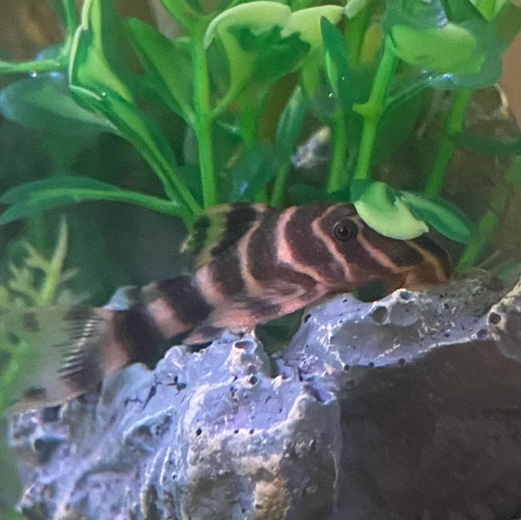
| Scientific Name: | Peckoltia vittata |
| Family: | Loricariidae |
| Care Level: | Moderate |
| Temperament: | Peaceful |
| Color: | Alternating light and dark stripes |
| Lifespan: | 10 to 15 years |
| Size: | 5 to 6 inches |
| Diet: | Omnivorous. Feeds on Algae, proteins, and sinking pellets. |
| Minimum Tank Size: | At least 30 gallons. |
| Temperature: | 75 to 82F |
| Water Conditions: | pH 6.5 – 7.5 Soft to moderate hardness |
| Tank Mate Compatibility | Peaceful fish |
Native to Brazil, the Candy Striped Plecos live in areas with fast water flow and rocky substrates. While a single species of pleco can’t be identified as “Candy Striped”, most of them have bold horizontal stripes that makes them highly sought after.
Although they have a common pleco-like body shape, their red and white striped patterns are a highly sought after thing among aquarists. The patterns extend along its entire body.
Candy Plecos can be a bit territorial during mating seasons. A larger tank and adequate hiding spot often diminish the issue.
14. Inspector Pleco
| Scientific Name: | Hypancistrus inspector |
| Family: | Loricariidae |
| Care Level: | Moderate |
| Temperament: | Peaceful |
| Color: | Cream or white with dark spots |
| Lifespan: | 10 to 12 years |
| Size: | 4 to 6 inches |
| Diet: | Omnivorous. |
| Minimum Tank Size: | At least 30 gallons. |
| Temperature: | 78 to 84F |
| Water Conditions: | pH 6.0 – 7.5 Soft to moderate hardness |
| Tank Mate Compatibility | Peaceful fish |
Native to the Rio Orinoco basin in Venezuela, Inspector Plecos are peaceful, nocturnal, and efficient algae-eaters. It has black or dark body with yellow or white bold markings. Their males may have bristles around their head and mouth to lure the females during breeding season.
Their diet consists of an omnivorous range of foods. But, they derive the most nutrition from veggie matters, algae, and sinking pellets. Moreover Inspector plecos also are pretty efficient algae scrapers.
15. Butterfly Pleco
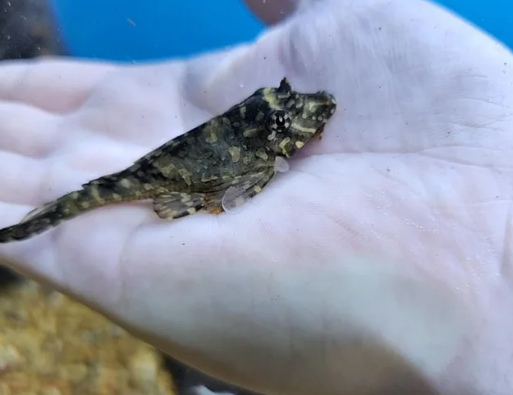
| Scientific Name: | Dekeyseria spp. |
| Family: | Loricariidae |
| Care Level: | Moderate |
| Temperament: | Peaceful |
| Color: | Dark brown with intricate patterning |
| Lifespan: | 10 to 15 years |
| Size: | 5 to 6 inches |
| Diet: | Omnivorous. Feeds on Algae, sinking pellets, and protein-based food. |
| Minimum Tank Size: | At least 30 gallons. |
| Temperature: | 78 to 84F |
| Water Conditions: | pH 6.0 – 7.5 Soft to moderate hardness |
| Tank Mate Compatibility | Peaceful fish |
Butterfly Plecos are fascinating to observe due to their nocturnal behavior and impressive camouflage abilities. They typically sport a dark brown or black base color with patches of yellow that can change with lighting conditions.
These fish are avid algae-eaters. But they need supplemental food like vegetables and live prey to sustain their health. They also feed on driftwood and produce substantial waste, necessitating a robust filtration system for their care.
To showcase their colors, maintain a relatively dim and subdued tank environment.
The Bottom Line
All these 15 freshwater plecos are great additions to your tank. While most of them are efficient algae-eaters, research their diet before considering them for practical purposes. Moreover, these plecos don’t have any premium water requirements and can co-exist together in community tanks.
No related posts.

